Are you looking for a storage device to upgrade your PC? A 1TB SSD is the best option. But with the growing popularity of SSDs, it's not always easy to find the best one: to make it easier, read this guide we've prepared to find the right 1TB SSD for your needs.
Here is our commitment, to make sure that we provide the best user experience and content quality:
You can support us by using our links to make your purchases (at no extra cost to you)! This sometimes earns us a commission which allows us to remain independent. More about us
Our selection
"Embedding 6th generation V-NAND technology, the 870 Evo performs at sequential speeds of up to 560MB/s read and 530MB/s write. A perfect SSD for those…"
"Sold at a lower price, the Crucial BX500 at 1Tb will be ideal to upgrade your PC. With a 2.5 format and a Sata III…"
"Discover a robust and responsive external storage solution designed for demanding users. Developing a nomadic look, G-DRIVE R-Series is a compact and rugged portable SSD…"
"Experience an M.2 NVMe-based SSD for unmatched performance with the Sandisk Extreme pro 3D M2 1TB. This SSD offers read speeds up to 3400MB/s and…"

Embedding 6th generation V-NAND technology, the 870 Evo performs at sequential speeds of up to 560MB/s read and 530MB/s write. A perfect SSD for those looking for reliability, performance and endurance.
99,92 £ on AmazonThe 870 Evo is a 2.5-inch model of the SSD intended for computers with a Sata interface. With its performances, it announces speeds up to 560 mo/s in reading and 530 mo/s in writing with an AES encryption of 256 bits. This represents high-level values for a Sata 2.5 model. This SSD is equipped with the latest generation of 3-bit TLC V-NAND flash memory.
The 870 Evo features Intelligent TurboWrite technology to accelerate write speed while maintaining high performance over the long term via a larger buffer. It even comes with an MKX controller to enable a more stable experience. With its 1TB capacity, the SSD comes with a high endurance rating of up to 600 TBW over a five-year warranty.
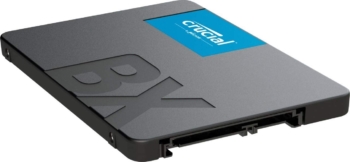
Sold at a lower price, the Crucial BX500 at 1Tb will be ideal to upgrade your PC. With a 2.5 format and a Sata III 6 Gb/s interface, it is equipped with high performances allowing to gain in speed and reactivity.
64,79 £ on AmazonThe Crucial BX500 at 1TB features 96-layer Micron TLC 3D Nand memory technology with a 6Gb/s Sata III interface. Equipped with a Silicon Motion SM2258XT controller, the SSD announces a read speed of 540 MB/s and 500 MB/s in writing. With its low cost, Micron's 3D Nand technology allows for low power consumption while improving the overall responsiveness of the PC.
With a 2.5-inch form factor, the BX500 benefits from a writing capacity of up to 360 TBW with a 3-year manufacturer's warranty. Presenting a compact design, it defines a thickness of 7 mm on a depth of 100,3 mm for a weight of 55 grams. Its structure includes an aluminum chassis with a plastic assembly to ensure good strength and adequate rigidity.
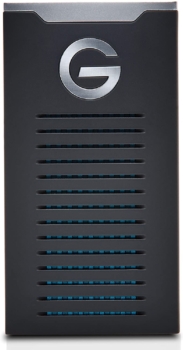
Discover a robust and responsive external storage solution designed for demanding users. Developing a nomadic look, G-DRIVE R-Series is a compact and rugged portable SSD with sequential speeds of 560MB/s.
188 £ on AmazonFrom the Western Digital brand, G-technology launches a 1TB Mobile external SSD oriented for demanding users. Offering a portable storage solution, G-DRIVE R-Series 1TB defines a compact structure with transfer performance up to 560MB/s. Equipped with a Thunderbolt-enabled USB-C 3.1 10Gbps interface, it is also compatible with USB Type-A 3.0 and 2.0 connectivity. Suitable for MAC OS, the SSD supports Windows systems via reformatting.
The SSD adopts a robust and reliable aluminum and ABS casing to maintain high performance at all times and prevent overheating. It also features anti-shock mounts and internal vibration. The SSD determines a resistance to water and dust IP67. Regarding its dimensions, the device includes a thickness of 14.5 mm with a width of 50 mm and a length of 95 mm for a weight of 86 grams. Supplied with a USB-C cable and a USB-A cable, the storage drive comes with a 5-year limited warranty.

Experience an M.2 NVMe-based SSD for unmatched performance with the Sandisk Extreme pro 3D M2 1TB. This SSD offers read speeds up to 3400MB/s and 500K IOPS in random read.
114 £ on AmazonClaiming a longevity of up to 600 TBW, the Sandisk Extreme Pro 3D is an M.2 PCIe NVMe SSD that establishes performance of up to 3400 MB/s read and 2800 MB/s write. This model is ideal for users looking for a high and reliable upgrade. The device is even capable of 500,000 random read IOPS to deliver high quality throughput.
The SSD features 3D Nand TLC technology and installs in PCs with M.2 NVMe PCIe 3.0 x4 interfaces. Defining an M.2 2280 form factor, it is also backwards compatible with PC Ie 2.0 x4. The 1TB SSD features Sandisk nCache 3.0 technology using advanced algorithms with multi-level caching to enhance performance, endurance, and read and write speeds.
Any specific needs?
The best high-end 1TB external SSD
Your guide :
Rate this buying guide :By rating this buying guide, you are helping us to reward our best writers. Thank you!
| Top of the line | Inexpensive | Top of the line | Excellent | |

In accordance with our commitment, this buying guide does not contain any sponsored products. |
 9/10 |
 7/10 |
 8/10 |
 8/10 |
| OUR SELECTION |
Samsung SSD 870 EVO, 2.5'' 1Tb
|
Crucial BX500 1TB
|
G-Technology G-DRIVE R-Series 1 TB
|
SanDisk Extreme PRO 3D M.2 NVMe 1 TB
|
|
Embedding 6th generation V-NAND technology, the 870 Evo performs at sequential speeds of up to 560MB/s read and 530MB/s write. A perfect SSD for those looking for reliability, performance and endurance.
|
Sold at a lower price, the Crucial BX500 at 1Tb will be ideal to upgrade your PC. With a 2.5 format and a Sata III 6 Gb/s interface, it is equipped with high performances allowing to gain in speed and reactivity.
|
Discover a robust and responsive external storage solution designed for demanding users. Developing a nomadic look, G-DRIVE R-Series is a compact and rugged portable SSD with sequential speeds of 560MB/s.
|
Experience an M.2 NVMe-based SSD for unmatched performance with the Sandisk Extreme pro 3D M2 1TB. This SSD offers read speeds up to 3400MB/s and 500K IOPS in random read.
|
|
|
Type & Format
|
Internal 2.5 inch
|
Internal 2.5 inch
|
External SD 1.8 inch
|
Internal M.2 NVMe 2280
|
|
Connector
|
Sata III 6 Gb/s
|
Sata III 6 Gb/s
|
USB-C & USB-A
|
NVMe PCIe 3.0 x4
|
|
Performance (read/write)
|
560 MB/s - 530 MB/s
|
540 MB/s - 500 MB/s
|
560 MB/s - 560 MB/s
|
3400 MB/s - 2800 MB/s
|
|
Durability Index
|
600 TBW
|
360 TBW
|
NC
|
600 TBW
|
|
Warranty
|
5 years
|
3 years
|
5 years
|
5 years
|
Help us improve this table:
Report an error, request the addition of a feature to the table, or suggest another product. Thank you for your kindness!
We spend thousands of hours each year studying the major specialized websites, analyzing products of hundreds of brands and reading user feedback to advise you on the best products.
We are a product review company with a single mission: to simplify your buying decisions. Our research and testing helps millions of people every year find the best products for their personal needs and budget.
To support us you can: use our links to make your purchases (which often earns us a small commission), share our articles on social networks, or recommend our site on your blog. Thanks in advance for your support!
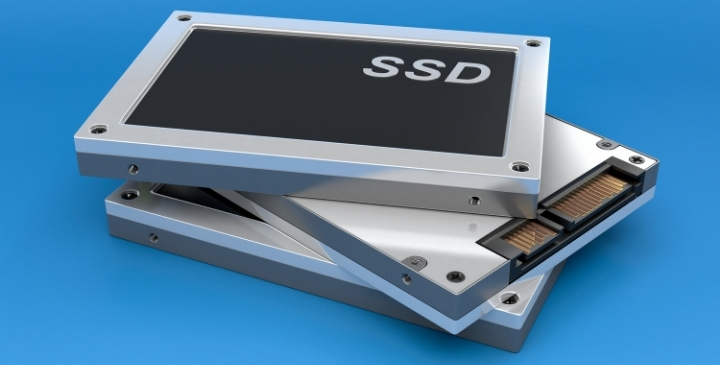
First of all, it is important to define the type of use you intend to put your future SSD to. In this regard, you will be faced with two types of usage, including internal storage and external media.
Basically, external SSDs have enclosures equipped with USB Type-C or Type-A connector depending on the model to connect to your PC. This type of SSD is mainly designed for digital storage, backup or data transfer.
Internal SSDs, on the other hand, will integrate directly on the PC's motherboard via supported protocols. We distinguish the SATA bus and PCIe or PCI Express. The SSD will serve as storage media and will also contribute to the performance to access different applications and features of your PC.
The most common and popular are the 2.5'' and M.2 SSD formats. The 2.5-inch SSD will adopt a classic HDD format but will be more powerful and with a much more compact size. It uses the SATA and mSATA connection interface developing read and write speeds up to 500 MB/s or even higher. The M.2 SSD defines a thinner form factor like RAM. This one uses PCIe and NVMe protocol, but can also have an mSATA interface. This SSD performs with sequential speeds ranging from 600 to over 1000 MB/s. However, you should check the compatibility of the SSD format supported by the computer's motherboard configuration.
This characteristic corresponds to the data transfer speed and will depend mainly on the type of connector used. The SATA III connection will offer a speed ranging from 400 to 650 MB/s, while PCIe will offer a speed of 700 up to 2500 MB/s in reading and even more on NVMe. Indeed, SSDs differ by their digital interface to transfer data. As said before, some use the SATA protocol while other models will use the NVMe interface on the PCIe bus. Thus, the SSD you choose will make a difference for faster boot time with high read and write performance. The performance will also be significant for any processing that requires extensive multitasking capabilities.
It should be noted that all flash memory has a limited lifespan guaranteed by each manufacturer. A data storage cell will stop working after being written to several times. It is by this characteristic that the SSD will define its endurance and lifetime. These will be defined by the maximum amount of data written that the SSD storage drive can handle. In general, the lifetime is listed in terabytes or TBW (Terabytes Writing). It can also be advertised as the amount the SSD can handle per day over a manufacturer's limited warranty period, the unit of which is DWPD (Drive Writes Per Day). The majority of 1TB SSDs have an endurance rating ranging from 360 to 600 TBW over a limited warranty of 3 to 5 years.
It seems a bit trivial to specify the capacity of the SSD drive of your choice, as more storage space would be the better. But beware, storage drives categorized in the 1TB capacity are variable depending on their components. Some 1TB SSDs come with slightly less capacity than advertised. For example, instead of 1024GB, a 1TB SSD may have a capacity of 960GB or even slightly less. But on the other hand, this missing part will be dedicated to optimize the performance and to take over the defective cells. So don't be fooled by a slightly lower capacity than advertised. A 1TB SSD with a slightly lower capacity does not mean that it will be less durable. It will just have a different architecture with a part reserved for optimization and troubleshooting in case of faulty cells.
Representing a key component of a computer, an SSD drive adopts new technologies to contribute to the performance of the PC in data encoding and backup. Unlike HDDs, SSDs use an electronic system consisting of a board with an interface such as SATA or PCIe driven via AHCI or NVMe protocol. They consist of flash memory as a platter to save data permanently. And to ensure its operation, the SSD has a cache memory as well as a controller with firmware.
The controller defines an intermediate system between the SSD and the motherboard to ensure the required reading and writing. The controller will also take care of error checking and management with the execution of Wear Leveling. At this level, it will be a wear leveling defining a system used with flash memory designed to extend the life of the SSD.

The 2.5" SSD is a standard and most common SSD format. It uses the same connectivity as SATA-interfaced mechanical HDDs and uses an AHCI transmission protocol. This type of SSD has been oriented to minimize the replacement of SATA cables in order to guarantee a simpler transition to higher performance. By the way, there is also the SSD called mSATA or Mini-SATA card designed for slim and ultra-books. The mSATA card defines a bare structure to connect directly to the motherboard and weighs only between 6 and 7 grams. On the performance side, the SSD 2.5 allows data processing with maximum speeds of up to 550 MB/s for reading and up to 600 MB/s for writing.

Determining a thinner architecture, the SSD M.2 comes as a RAM memory strip in the shape of a small thin rectangle. It uses a smaller connector standard on an interface in SATA or PCI Express compatible with the NVMe transfer protocol. Note that NVMe is an M.2 PCIe transfer standard designed to replace the AHCI standard in SATA. Because of its interface, an M.2 SSD performs with the highest transfer speeds that can reach up to 5000 MB/s depending on its components and model.
But it should be noted that an M.2 SSD in SATA III will only develop more or less the same performance as a classic 2.5 SSD with maximum data rates of 600 MB/s. And for even higher performance, the M.2 SSD in NVMe can elaborate transfer speeds up to 2500 MB/s in PCIe 3.0 and at most 5000 MB/s in PCIe 4.0.
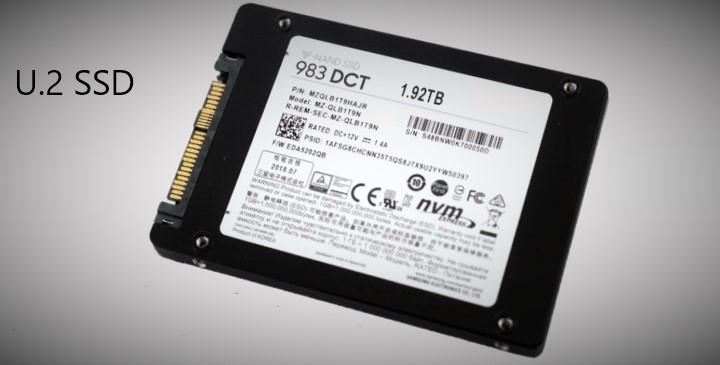
Little known and less prized by users, the U.2 SSD defines a new version of the SFF-8639 used in professional settings to benefit from a higher throughput level. In general, manufacturers present it as a 2.5-inch PCIe SSD that supports the NVMe storage protocol and interface. As a result, the U.2 SSD can meet the SATA Express standard, a section of the SATA v3.2 specification that supports both SATA and PCIe protocols simultaneously. In terms of performance, this type of SSD is somewhat identical to the M.2 and can elaborate speeds up to 4000 MB/s and more.
Coming in the form of a 2.5-inch SSD, the U.2 SSD has the shortcoming of not being compatible with small computers. In general, this type of SSD determines dimensions with 100 mm length, a width of 69.85 mm for a thickness ranging from 7 to 15 mm. It can also be said that there are few motherboards with U.2 interfaces.
Unlike mechanical HDDs, the 2.5-inch SSD incorporates non-mechanical Nand Flash memory mounted on printed circuit boards. Less noisy and more energy efficient, this type of SSD uses the SATA III connection bus to achieve transfer and execution speeds of 500 to 600 MB/s. Used for file storage, the 2.5-inch SSD is primarily designed to support a PC's operating system and access various applications.
To its advantage, the 2.5" SSD offers near-zero load time for better multitasking with a quieter system that cools down more easily. With no mechanical parts, it is more robust and reliable.
Its only flaw is wear and tear where the cells that store data are limited in the number of writes. The 2.5-inch SSD cannot be used for continuous writing operations as in the case of surveillance systems or servers.
Using the same technology with electronic components as 2.5 SSDs, the M.2 SSD is distinguished by more compact dimensions as a RAM memory strip. This type of SSD defines a thinner structure and is attached to the M.2 connector of the motherboard in SATA III interface or PCI Express supporting the NVMe protocol. The M.2 SSD was designed primarily for demanding users looking for very high performance. As an indication, in PCIe NVMe, the SSD can perform on read speeds of 3500 MB/s with a write speed of 2000 MB/s. In SATA III, it will only be limited to read and write speeds of around 550 MB/s. However, it is advisable to check the M.2 compatibility on the motherboard before opting for an M.2 SSD.
Although very powerful, the M.2 SSD is rather suitable for storing the operating system and the most important applications. It is not too oriented for volume storage. It also has the drawback of being more expensive to buy.
Indeed, the choice will depend on the compatibility of the motherboard. The 2.5" SSD would be a better alternative to upgrade and gain performance on your PC. But if your motherboard has a PCIe M.2 connector, the M.2 format would be better for ultra-fast system and application execution. But beware, the latter will be less reliable for high volume data storage. Otherwise, if your budget allows it and your motherboard has both SATA III and PCIe connectors, opting for an M.2 as the primary drive and a 2.5 as the secondary would be even better.
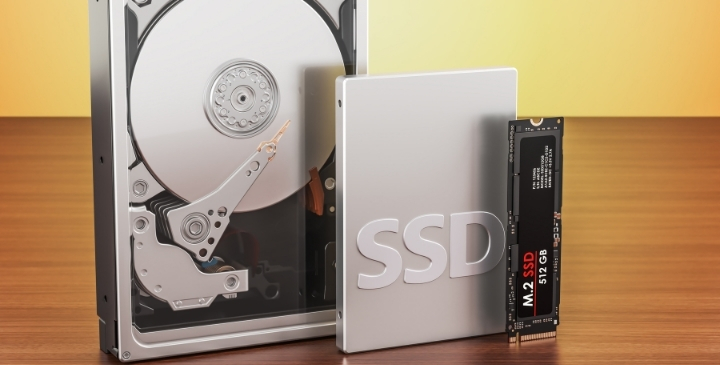
Taking advantage of a more advanced technology particularly adapted to the use of a PC, the 1TB SSD has become the most popular storage medium for both private individuals and professionals. This is due to a whole host of advantages over the old mechanical HDDs.
Performance
Working with electronic components, SSDs are designed with increased performance levels. Depending on the interface protocol, a 1TB SSD can develop high-level data rates of 500MB/s in SATA III and nearly 3000MB/s in PCIe. This will allow a faster startup and shorter loading times. It will also offer a much smoother multitasking with important data access capabilities with ease.
Capacity and durability
A 1TB SSD allows for greater capacity with ease of multi-tasking and much more flexible storage support. Logically compared to a lower capacity SSD, a 1TB SSD will set a much higher endurance rating over a guarantee of years of use.
Energy efficiency
With no mechanical parts, 1TB SSDs offer your system instant performance while requiring little power to get the job done. When in operation, an SSD is more energy efficient. It can improve the battery life of your laptop and minimize power consumption on your desktop PC.
Robustness and security
Because of their design using electronic rather than mechanical components, SSDs have the advantage of being more resistant to shock and vibration. They are more resistant to temperature variations and are characterized by low operating temperatures. As a result, a 1TB SSD improves user comfort while reducing the heat emitted to other computer components.
Less Noisy
Unlike HDDs, SSDs are distinguished by their quiet operation. Due to the absence of mechanical parts, they will be devoid of humming or buzzing even under heavy use.
In our opinion, the best brands of SSD in 2022 are :
Samsung is a leading South Korean brand in the field of electronics and is one of the most important players in the new technology. Its great reputation lies mainly in the quality of its computer products, smartphones, tablets, televisions as well as household appliances etc. Highly sought after by both individuals and professionals, Samsung offers SSDs of impeccable quality, both in terms of design and performance, on both internal and external models.
Directly attached to the Micron Technology group, Crucial is a brand that is entirely invested in the memory and computer storage sectors. Highly reputed in the field, the brand takes advantage of new ideas with innovative technologies to offer the quality and reliability of its products. In its catalog, Crucial offers a wide range of SSDs in 2.5-inch or M.2 format to meet the needs of every user across a range of prices.
Founded in 1988, SanDisk is an American brand that quickly built a reputation through the manufacture and distribution of flash memory-based storage media. Renowned for the solidity and the quality of its products, the brand is especially known for its wide variety of mini SD, USB key as well as SSD hard disk. Essential in the field of computer storage, SanDisk provides SSDs with high level performances at diversified and accessible prices for all.
Designated by its acronym WD, the Western Digital brand makes its beginnings in the 1970s in the data storage sector. It is distinguished by a wide range of storage solutions oriented for durability and performance in all forms, internal or external. Offering different formats of hard drives, SSD 2.5 and M.2, the brand evolves with new technologies while addressing all needs and budgets.
Created in 1994, Corsair is an American brand oriented in computer components. The brand is best known for the integration of random access memory (RAM). Working with major brands like Samsung, the brand expands its field of activity on a wide variety of computer products such as keyboards, mice, headphones, hard drives etc. When it comes to storage devices, Corsair is making a name for itself with SSDs that deliver incredible performance and rock-solid reliability.
The diagram below will help you to get an idea of the typical prices for each price range (entry-level, mid-range and high-end).
However, more expensive does not necessarily mean better.
We therefore advise you to always consult our ranking before deciding, rather than blindly relying on price ranges.
The main steps to install your SSD correctly
If you want to clone your old disk to your SSD, it is essential to use a cloning kit including a cable to connect to the USB port of your PC and a transfer CD. You will have to copy the content of the original disk to the SSD by following the steps prescribed by the transfer CD. This step is very simple and remains in a few clicks and several minutes of transfer depending on the volume of data to be transferred.
To install your SSD, it is essential to turn off and unplug your PC and remove the side or top panel of the chassis. Then remove the old disk by disconnecting the connection cables. After this step, you can start screwing the SSD onto the rails of the 2.5" to 3.5" adapter if necessary to position it in the storage drive bay. For laptops, the SSD fits directly into the SATA interface connector. While for desktop PCs, it will be necessary to connect it to the SATA cable and the power supply of the old disk on the motherboard. You can finish by closing the chassis panel and reconnecting the power supply to turn on the PC. And finally to take full advantage of the performance of your new SSD, it will be important to set the SATA port to AHCI in the BIOS system.
Correct usage to keep your SSD running smoothly and performing well
When using your SSD, it is highly recommended to use antivirus software and always keep it updated. Be aware that an SSD affected by any virus could lose performance and lifespan. Also for proper usage, most manufacturers advise to keep at least 15% of storage space free to take full advantage of SSD performance. So try to remove unnecessary data from your drive to ensure a good balance between performance and storage. When using your SSD, it is best to have a strong antivirus software and not to fill up the entire available storage to avoid disk saturation.
Activate the TRIM command to optimize your SSD
This is because the memory cells used in SSDs have a limited write life. And that even if the unused data is properly erased, it will still be kept as erasable data. The TRIM function will then allow you to limit this aspect by generating a homogeneous wear. Above all, it will optimize the speed and improve the lifespan of your SSD. Replacing the defragmentation function, the TRIM function is automatically detected by Windows when you use an SSD storage medium. Normally, the command is enabled by default. If not, you need to open the file explorer and right-click on the SSD. And access the property to be able to then optimize it via the TRIM command in the "Tools" tab.
Use an old internal SSD drive for external storage
When you make the choice to replace your old internal SSD with a more powerful one, be aware that your old disk will be able to serve you as an external and mobile storage space. You will have the ability to benefit from more storage space. You could use it as a USB flash drive with larger capacities to store and back up other important documents, videos, photos and more. To convert your internal drive to external, there are two alternatives, including the use of an external drive enclosure or a SATA to USB cable kit.
The external hard drive enclosure can be found at a very affordable price on the market. It determines a robust design and helps to protect the internal drive. It includes a USB connector to allow you to connect it to your PC. As for the SATA-USB kit, it is also available on the market for a few euros. To use it, you just need to connect the SATA part on your old SSD and the USB part on the USB connector of your computer.
Find the part number of the installed storage drive without having to open the computer's case
There is a very simple way to determine the reference and model of the storage disk installed on your computer. To make it simple, you just need to run in Windows by accessing the device manager. To start, you must click on "File Explorer" to then right click on the "This PC" or "Computer" or "My Computer" icon to left click on "Property".
After this step your screen will display a control panel window accessing the system. Try to locate the device manager button at the first list on the left side to click on it to find the list of all components of your PC. And to find out the reference and model of your, you will just have to open the "Disk drives" section. And in order to find the type of format, dimensions and connection interface used, you go to the internet and just type the reference and model of your disk.
In most cases, an unrecognized SSD comes from the BIOS system configuration or from an incorrect installation. In order to solve it, it will be necessary to check the installation of the SSD on the motherboard connection bus whether it is SATA or M.2. Then, try to set up your BIOS by accessing its system at startup and make sure the availability of the different storage disks present.
Except for the M.2 format, the majority of SSDs adopt the 2.5 format in SATA interface. For laptops, it would be simple to just remove the old mechanical drive and replace it with a 2.5 SSD without an adapter. On the other hand, desktop PCs use the 3.5 format in SATA. In this circumstance, you will have to use an adapter cradle for installation. For info, this is an easily accessible accessory on the market.
Despite their incredibly high performance, SSDs remain limited in terms of write and erase cycles. But to find out about the index of its longevity and endurance, there are software dedicated to this subject. Among the most well-known and used, CrystalDiskInfo and SSDLife represent the specific software for many information about your SSD drives, including their current status and life span.
PCIeor PCI Express is a transmission bus of a connector used on the motherboard. It defines a physical connection designed to transmit data from one device to another. Similar to a SATA connector, this one adopts four lanes for storage drives to bring more performance. As for NVMe or "Non Volatile Memory Express", it determines a communication protocol particularly oriented for the NAND technology or flash memory of an SSD on the PCIe connector for higher performance.
Every month we help more than 1 000 000 people buy better and smarter.
Copyright © 2022 - Made with ♥ by buyingbetter.co.uk
Your reviews and buying guides 0% advertising, 100% independent!